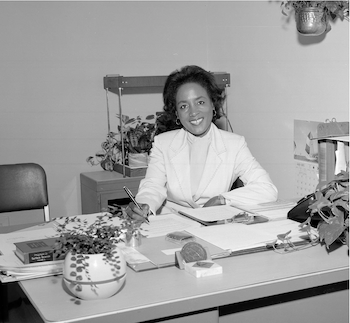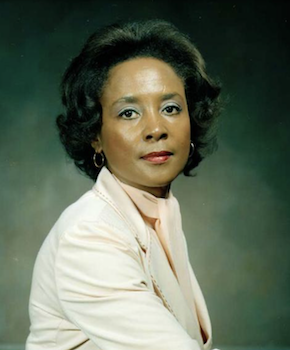
Annie Jean Easley was an American computer scientist, mathematician, and rocket scientist born on April 23, 1933, in Birmingham, Alabama. Easley and her brother, who was six years older than her, both grew up in Birmingham with their parents, Samuel Bird Easley and Mary Melvina Hoover. Her family members always told Easley to believe in her true passions. In Easley’s early childhood years, she wanted to pursue an occupational career as a nurse; however, she soon found an interest in STEM fields. Attending fifth grade through high school in her hometown, she would eventually graduate as valedictorian of her class. Easley also grew up during the American Civil Rights Movement, where educational opportunities for African Americans were largely unavailable. During this time, many advocated for civil rights for African Americans through protests and marches. She received little to no resources; however with persistence and motivation she was able to accomplish her goals. Easley's role model was her mother who told her that with hard work and determination, successful goals will be achieved. With this foundation, Easley followed her passions and interests.
Easley studied pharmacy at Xavier University for two years, and went on to attend Cleveland State University, looking for a new career after the pharmaceutical program at Xavier University closed. In 1977, Easley graduated from Cleveland State University with a Bachelor of Science in Mathematics. After Easley returned from college, Jim Crow segregation laws were placed, impacting many African Americans in American society. Per these discriminatory laws, many African Americans had to pass a literacy test and pay a poll tax to cast their votes. Easley wanted to inform others on how to study and do well on such tests to further educate others.
While attending college, Easley advocated for the empowerment of women in technology and STEM-based field careers while simultaneously advocating for minority students. She did this by strongly advocating for the strength of women in the workforce.
Easley’s career took off when she read a local newspaper article about twin sisters who worked for the National Advisory Committee for Aeronautics (NACA), known today as the National Aeronautics and Space Administration (NASA) Furthermore, this immensely inspired her future career goals because she had desires work for NASA as well. She applied for a position at NACA and was offered the job while simultaneously attending college. Easley was one of the four African Americans among two thousand five hundred employees when she started her career as a computer engineer and mathematician.

Easley worked at the NACA Lewis Flight Propulsion Laboratory for nearly thirty-four years, implementing and developing new space and computer science solutions. In the center, she focused on researching energy-conversion systems and analyzing data specifically. Easley assisted with the Centaur upper-stage rocket, which has affected future space shuttle journeys. Her collaboration with others during the initial development and staging process yielded great achievement.
During her time at NASA, Easley faced racial discrimination daily. One instance was when she was photographed with her colleagues for NASA’s promotional images. As the photos were displayed to the general public, she was shocked to see that she was cut out of them. However, the discrimination did not stop there. Easley was not offered any financial aid from NASA’s which other workers received to pay for college courses. In addition, she was not informed why she was not offered financial aid. On the other hand, Easley’s determination allowed her to accept the situation and move on. Thus, such situations did not stop her from achieving her career goals.
Easley and her coworkers’ efforts tremendously contributed to the 1977 Cassini Probe flight to Saturn. The Cassini Probe spacecraft design was the main launcher of the Centaur upper-stage rocket. Moreover, Easley created, as well as, implemented software codes to interpret power technologies, worked on solar and wind power projects, and developed alternate solutions to pressing problems in society. These problems included solar-wind efficiency and sustainability. Her contributions have made a powerful impact on today’s society. For instance, today, her computer applications and resources are used to focus on energy-conversion systems and other modern technologies.
Easley retired from her job at NACA in 1991. Her potent contributions to space science and computer science technologies have allowed many researchers to explore innovative ideas. In her free time, she skied, volunteered at local places, and played tennis. She also worked at a part-time real estate company and oftentimes tutored students in complex subjects.
Annie Jean Easley died on June 25, 2011, in Cleveland, Ohio. Her legacy remains today as her significant contributions to STEM have influenced many around the globe. Not only has Easley’s work affected agencies such as NASA, but also opened opportunities for minority groups to participate in STEM fields. Easley’s mission was to inspire others around her and empower young women to pursue their careers, passions, and motivational goals. Ultimately, Easley is a remarkable historical figure who has made significant contributions and set the stage for future space travel.
Why Did I Choose to Research Annie Easley?
I chose Annie Jean Easley to research for various reasons. Annie’s work ethics and goals were interesting and inspiring through my initial research. Her contributions to society have affected how many view STEM. As Easley was a computer scientist, her achievements and accomplishments inspire me to pursue my passions and interests. Furthermore, her work efforts also inspire me to create solutions to problems in various fields. All in all, through my research findings, Easley’s work and contributions had a tremendous impact and influence.
Works Cited
Annie EASLEY. (n.d.). Scientific Women. Retrieved May 18, 2022, from https://scientificwomen.net/women/easley-annie-160
Annie Easley, Computer Scientist. (2015, September 21). NASA. Retrieved May 18, 2022, from https://www.nasa.gov/feature/annie-easley-computer-scientist
Annie Easley, Computer Scientist and Mathematician. (2017, March 16). NASA. Retrieved May 18, 2022, from https://www.nasa.gov/image-feature/annie-easley-computer-scientist-and-mathematician
Annie Easley - Glenn Research Center | NASA. (2021, July 30). Glenn Research Center. Retrieved May 18, 2022, from https://www1.grc.nasa.gov/glenn-history/hall-of-fame/biographies/annie-easley/
Carpenter, J. (2020, March 13). Annie J. Easley (1933-2011) •. Blackpast. Retrieved May 18, 2022 from xhttps://www.blackpast.org/african-american-history/annie-j-easley-1933-2011/
Easley, Annie J. (n.d.). Encyclopedia.com. Retrieved May 18, 2022, from https://www.encyclopedia.com/education/news-wires-white-papers-and-books/easley-annie-j
Five Fast Facts about Rocket Scientist Annie Easleyx. (2016, March 10). Department of Energy. Retrieved May 18, 2022, from https://www.energy.gov/articles/five-fast-facts-about-rocket-scientist-annie-easley
Meet Annie Easley, the barrier-breaking mathematician who helped us explore the solar system. (2018, November 26). Massive Science. Retrieved November 19, 2022, from https://massivesci.com/articles/annie-easley-facts-stem-mathematician-nasa-scientist-discrimination/
This article was published on 2/9/24